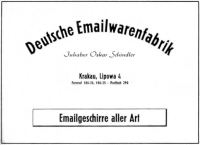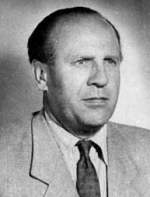 |
| Oskar Schindler |
Oskar Schindler was born on
28 April 1908 in
Zwittau
(
Sudetenland / today: Moravia). His father was owner of a farm-machinery plant. The Schindler family belonged
to the German-speaking Catholic community in the former
Sudetenland. Young Schindler became member of the NSDAP
after the German annexation of the
Sudetenland.
In
September 1939, he came to
Krakow, shortly
after the occupation by German troops.
Poland has changed into an interesting field for German businessmen because the property of around 60,000
Krakow Jews was confiscated and factory buildings, workshops and houses were
waiting for new owners...
Supported by German authorities he was able to take over two companies previously owned by Jews, dealing with
the manufacture and wholesale distribution of enamel kitchenware products. One of which he operated as a trustee
for the German occupation administration.
In
October 1939, he established his own factory in a run-down former Jewish enamel works in
Zablocie (outside
Krakow),
assisted by
Isaak Stern, a clever jewish accountant. The production of enamel
kitchenware for the German Army became the base for Schindler's success. In
January 1940 Schindler employed 250 Poles and seven Jews. Two years
later his small factory has grown to a big company where 370 Jews from the
Krakow Ghetto together with around 430 non-jewish Polish workers were employed.
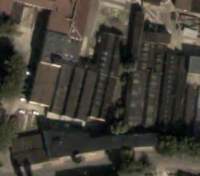 |
| The Schindler Factory |
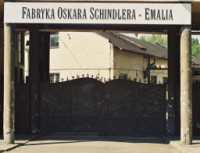 |
| Emalia Factory in Krakow |
Schindler soon adapted his lifestyle to his income. He became a well-respected
guest on SS parties, having easy chats with high-ranking SS officers, often for his benefit. On the other hand
he treated his Jewish employees very human.
Realizing the brutal treatment of the
Krakow Jews he changed his opinion about
Nazis and Jews. From now on Schindler tried to help "his" Jews to survive. In order to help his Jewish
employees he brought his money and even his security into play. The special status of his factory ("business
essential to the war effort") became the decisive factor for his efforts to support his Jewish workers. Whenever
the "Schindler Jews" were threatened with deportation he could claim exemptions
for them. Wifes, children and even handicapped persons were showed to be necessary mechanics and metalworkers.
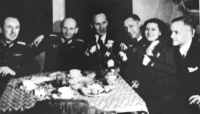 |
| Schindler (center) at a SS Party |
When the
Krakow Ghetto was liquidated in
March 1943,
many Jews were sent to the
Plaszow forced labour camp, outside
Krakow.
Schindler took advantage of his good connections to
Amon Goeth, the brutal
Plaszow camp
commander, to obtain the permission to establish a branch of his factory outside of the
Plaszow camp, in
Zablocie. There he
employed around 900 mainly Jewish workers, partially unfit or unqualified for metal works. So he spared them
from the horrors of
Plaszow.
In
October 1944, with the approach of the Soviet Army, Schindler was granted
permission to re-establish his firm as an armaments production company in
Brünnlitz,
Sudetenland.
After having rescued his workers from death in
Groß-Rosen KZ and
Auschwitz (where they were sent by the SS),
he took with him around 1,100 people from
Zablocie. Meanwhile 20,000 Jewish
inmates of
Plaszow were sent to the
gas chambers of
Auschwitz-Birkenau.
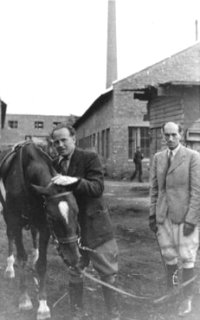 |
| Schindler with his Horse |
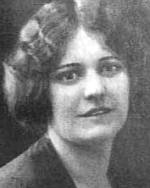 |
| Emilie Schindler |
In
Brünnlitz the 1,100 Jewish workers were given the most humane treatment
possible, some feat as the factory at
Brünnlitz was commanded by
SS-Obersturmführer Josef Leipold, who had once commanded the
Budzyn labour camp, near
Lublin.
At the end of the war a sealed train with 120 evacuated Jewish men from the
Goleszow Camp (sub-camp of
Auschwitz)
was stranded at nearby
Svitavy, after a seven-day journey without food and water.
Emilie Schindler could obtain that the SS leave the Jews at
Brünnlitz.
Her husband finally received permission to accept these poor people for "necessary work". 120 nearly frozen persons
were swiftly taken to the
Brünnlitz factory where they had a chance
to survive. 13 persons were frozen to death. Schindler managed that they were not cremated in the factory's oven but
buried according to Jewish tradition.
 |
| A List * |
During the last days of WW2 Schindler fled to Germany, meanwhile being bankrupt.
Later he emigrated to South America, financially supported by Jewish relief organizations and groups of survivors.
Since
1961 he visited Israel 13 times, always welcomed by the "Schindler Jews"
who had survived.
Oskar Schindler died in
October 1974 in
Hildesheim,
Germany. His remains found a rest in
Jerusalem. On
18 July 1967, Yad Vashem decided to recognize him as "Righteous Among the Nations".
On
24 June 1993, the decision was extended also to his widow,
Emilie Schindler.
Photos:
Robin O'Neil Private Collection
*
© ARC 2005








